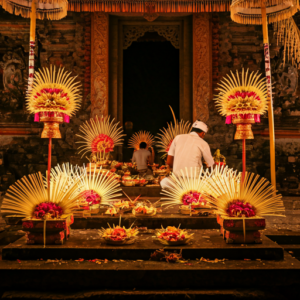
Bali, often revered for its stunning beaches, lush landscapes, and vibrant culture, also boasts a thriving coffee scene that is as rich and diverse as its traditions. The island’s coffee culture has deep roots, reflecting a blend of ancient farming techniques and modern innovations. From the verdant coffee plantations that dot its highlands to the trendy cafes in Ubud and Seminyak, Bali offers a unique journey from beans to brew that captivates both casual drinkers and connoisseurs alike.
The History of Coffee in Bali
Coffee was introduced to Indonesia by Dutch colonialists in the late 17th century, and it quickly spread across the archipelago. Bali’s fertile volcanic soil and ideal climate conditions, particularly in regions like Kintamani, provided a perfect environment for cultivating high-quality coffee. The Kintamani region, situated at an altitude of 1,300 to 1,700 meters above sea level, is renowned for its Arabica coffee. The beans from this area are known for their distinctive citrusy notes, a characteristic attributed to the unique terroir and the traditional intercropping with citrus trees.
The Cultivation Process
Bali’s coffee cultivation is largely a communal effort, with many smallholder farmers practicing organic farming methods. The process begins with the careful selection of coffee seeds, which are then planted in nurseries until they are robust enough to be transplanted to the fields. The coffee plants are meticulously tended to, ensuring they receive ample shade, often provided by taller trees in the plantation, which also helps maintain the biodiversity of the area.
The harvesting process is labor-intensive, requiring a keen eye and deft hands. Only the ripe, red cherries are picked, often by hand, ensuring that the quality of the coffee is maintained. This selective harvesting method is crucial in producing a high-quality cup of coffee, as overripe or underripe cherries can significantly affect the flavor profile.
Processing Methods: Wet and Dry
Once harvested, the coffee cherries undergo one of two primary processing methods: wet (washed) or dry (natural). In the wet process, the cherries are pulped to remove the outer skin and then fermented to eliminate the mucilage before being washed and dried. This method tends to produce a cleaner, brighter cup with more pronounced acidity. Conversely, the dry process involves spreading the cherries out in the sun to dry as whole fruit, which often results in a sweeter, fuller-bodied coffee with complex fruit notes.
In Bali, the choice of processing method can vary by region and even by individual farm, contributing to the rich tapestry of flavors that Balinese coffee offers.
The Unique Kopi Luwak
No exploration of Bali’s coffee culture would be complete without mentioning Kopi Luwak, one of the world’s most expensive and controversial coffees. Produced from beans that have been eaten and excreted by the Asian palm civet, Kopi Luwak is said to have a smoother, less acidic flavor due to the enzymatic action in the civet’s digestive system. While some tout its unique taste, ethical concerns regarding the treatment of civets in captivity have led to calls for more sustainable and humane production practices.
From Plantations to Cafes
The journey from beans to brew in Bali often involves a visit to a local plantation. These plantations offer tours that provide insight into every stage of coffee production, from the cultivation and harvesting to the processing and roasting of the beans. Visitors can walk through the rows of coffee plants, observe the drying process, and even participate in a cupping session to taste and evaluate different coffee profiles.
One notable plantation is the Bali Pulina Agro Tourism in Tegalalang, Ubud. Here, visitors can experience the full spectrum of coffee production and enjoy panoramic views of the terraced landscape. Another significant plantation is the Kintamani Coffee Plantation, which is famed for its organically grown Arabica beans.
The Roasting Process
Roasting is a critical step that transforms green coffee beans into the aromatic brown beans we recognize. In Bali, many roasters emphasize traditional methods, often roasting small batches by hand over an open flame. This artisanal approach allows for precise control over the roast profile, ensuring that the beans’ unique characteristics are brought to the forefront.
The type of roast—light, medium, or dark—greatly influences the flavor of the coffee. Light roasts tend to highlight the beans‘ intrinsic flavors, such as floral or fruity notes, while darker roasts bring out deeper, more robust flavors, often with a hint of smokiness.
Bali’s Coffee Houses and Cafes
Bali’s coffee culture extends beyond the plantations to its bustling coffee houses and cafes, which serve as social hubs and creative spaces. In areas like Ubud, Seminyak, and Canggu, cafes range from quaint, rustic settings to sleek, modern establishments, each offering a unique ambiance.
Seniman Coffee Studio in Ubud is a prime example of Bali’s vibrant coffee scene. Known for its innovative brewing techniques and focus on single-origin beans, Seniman offers a comprehensive coffee experience, from a detailed exploration of brewing methods to the enjoyment of meticulously crafted espresso-based drinks. Similarly, Revolver Espresso in Seminyak has gained a reputation for its stylish interior and exceptional coffee, attracting both locals and tourists.
The Role of Coffee in Balinese Culture
Coffee in Bali is more than just a beverage; it is an integral part of the island’s culture and daily life. Traditional Balinese coffee, often referred to as “kopi Bali,” is usually a dark, rich brew made by boiling coffee grounds with sugar and water, resulting in a thick, intense cup. This traditional preparation method is a staple in many Balinese households and is often enjoyed during social gatherings and ceremonies.
Moreover, coffee plays a role in various cultural practices and rituals. For instance, it is common to offer coffee during temple ceremonies as a gesture of hospitality and respect. This intertwining of coffee with Balinese customs highlights its significance beyond mere consumption.
Sustainability and the Future of Balinese Coffee
As global interest in specialty coffee continues to rise, there is a growing emphasis on sustainability within Bali’s coffee industry. Efforts to promote organic farming, fair trade practices, and eco-friendly processing methods are gaining traction. Organizations and cooperatives are working with local farmers to ensure that coffee production not only meets international quality standards but also supports the livelihoods of the farmers and their communities.
One such initiative is the Kintamani Coffee Farmers Cooperative, which focuses on enhancing the quality of Kintamani’s coffee while promoting sustainable agricultural practices. By providing training and resources, the cooperative helps farmers improve their yields and achieve better market prices, thus fostering a more sustainable and equitable coffee industry.
Conclusion
Exploring Bali’s coffee culture is a journey through the island’s history, landscapes, and traditions. From the careful cultivation of coffee plants in the highlands to the artisanal roasting and brewing in its cafes, each step reflects a deep respect for the craft and the community. As you sip a cup of Balinese coffee, you are not just enjoying a beverage; you are experiencing a rich cultural heritage that is as complex and satisfying as the coffee itself. Whether you are a casual coffee drinker or a passionate aficionado, Bali offers a unique and enriching coffee experience that is sure to leave a lasting impression.





